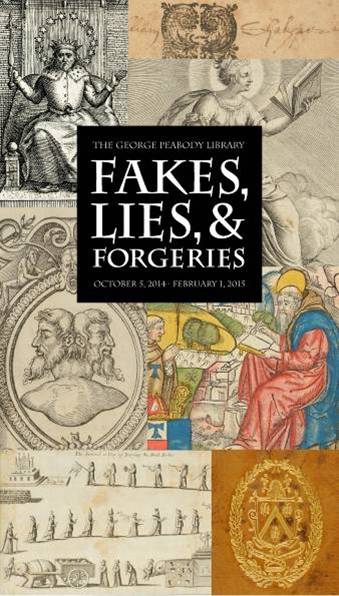 The George Peabody Library at Johns Hopkins University is home to the Artur and Janet Freeman Bibliotheca Fictiva Collection the world’s most comprehensive collection of rare books and manuscripts on the history of Forgery in the West. Gems from that collection are featured in a new exhibition entitled Fakes, Lies, and Forgeries, which opened on October 5th and runs through February 1st, 2015. Leiden University had a similarly-themed exhibition this year on Books, Crooks and Readers: the Seduction of Forgery (1600-1800), which closed on October 1st. The exhibition currently may be viewed online. Earle Havens, Curator of Rare Books and Manuscripts at the George Peabody Library told NPRs Weekend Edition why the subject of forgery is particularly relevant today: “Perhaps now, more than ever, we ought to be attending to the subject of authenticity, because we’ve already built another tower of Babel. That, of course is our Internet… He elaborated on this point to a reporter for the Baltimore Sun: There’s never been a time in the history of the world when it’s been more important for students to understand that they can’t trust everything they read. I agree completely with Havens and that conviction has been behind my occasional posts devoted to debunking one or another of the many pseudoscientific claims about Ohios ancient past. Havens makes the point that many of the forgeries featured in the librarys exhibition took a great deal of creativity to devise and a lot of work to execute. One of the questions that continually comes up in regard to archaeological forgeries, such as the Newark Holy Stones and the Michigan Relics, is Why would someone go to so much trouble to create them? The webpage for the Leiden University exhibition lists several motivations for forgeries, including politics (inventing national histories), fame and fortune (or, in the more properly prioritized phrasing of Indiana Jones fortune and glory), and just plain fun. You should never underestimate the motivating power of fun. Doug Bower, along with his partner in mischief Dave Chorley, created dozens of increasingly elaborate crop circles and mystified the world. Heres how he described their motivation: It was just pure enjoyment. We didn’t want to make publicity. We just wanted to make fools of the experts The lesson is clear. In archaeology, as in all else, caveat emptor. Brad Lepper
The George Peabody Library at Johns Hopkins University is home to the Artur and Janet Freeman Bibliotheca Fictiva Collection the world’s most comprehensive collection of rare books and manuscripts on the history of Forgery in the West. Gems from that collection are featured in a new exhibition entitled Fakes, Lies, and Forgeries, which opened on October 5th and runs through February 1st, 2015. Leiden University had a similarly-themed exhibition this year on Books, Crooks and Readers: the Seduction of Forgery (1600-1800), which closed on October 1st. The exhibition currently may be viewed online. Earle Havens, Curator of Rare Books and Manuscripts at the George Peabody Library told NPRs Weekend Edition why the subject of forgery is particularly relevant today: “Perhaps now, more than ever, we ought to be attending to the subject of authenticity, because we’ve already built another tower of Babel. That, of course is our Internet… He elaborated on this point to a reporter for the Baltimore Sun: There’s never been a time in the history of the world when it’s been more important for students to understand that they can’t trust everything they read. I agree completely with Havens and that conviction has been behind my occasional posts devoted to debunking one or another of the many pseudoscientific claims about Ohios ancient past. Havens makes the point that many of the forgeries featured in the librarys exhibition took a great deal of creativity to devise and a lot of work to execute. One of the questions that continually comes up in regard to archaeological forgeries, such as the Newark Holy Stones and the Michigan Relics, is Why would someone go to so much trouble to create them? The webpage for the Leiden University exhibition lists several motivations for forgeries, including politics (inventing national histories), fame and fortune (or, in the more properly prioritized phrasing of Indiana Jones fortune and glory), and just plain fun. You should never underestimate the motivating power of fun. Doug Bower, along with his partner in mischief Dave Chorley, created dozens of increasingly elaborate crop circles and mystified the world. Heres how he described their motivation: It was just pure enjoyment. We didn’t want to make publicity. We just wanted to make fools of the experts The lesson is clear. In archaeology, as in all else, caveat emptor. Brad Lepper